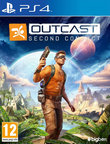We haven't half had a moan about remakes in the past here at Everybody Plays - but as we've always said, there are remakes that are cash grabs, and then there are remakes that genuinely make a difference. Outcast Second Contact sits firmly in the latter category. Originally released in 1999, it was a game your writer fondly remembers reading about in PC Zone - yet one that I never got chance to play. Held in high regard as a pioneer of the 3D open world game, Outcast was one of the very first games to set its story across not a level, but a collection of huge hubs, with dozens of missions held within. Without Outcast, who knows whether we'd have Assassin's Creed, The Witcher, or even games like Grand Theft Auto V.
As opposed to just giving the game a slight increase in resolution like most of the quick PS3 to PS4 ports, Outcast Second Contact is a game that's been totally rebuilt from the ground up, taking it from looking like this:
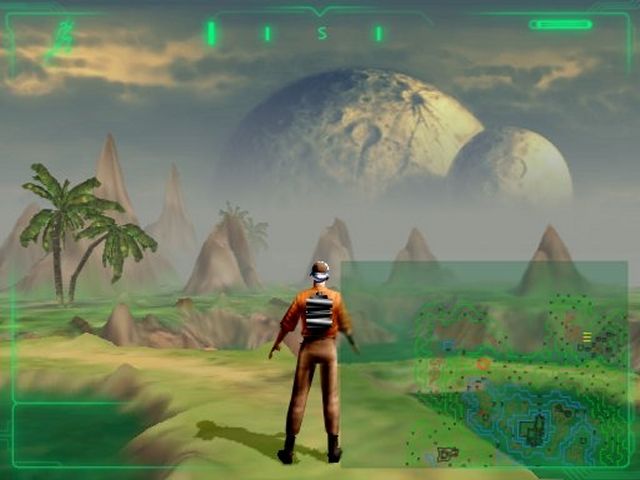
To looking like this:

You don't need to be a graphics expert to see there's a huge difference there - but what lurks beneath the surface is a game that clings firmly to its original 90s design. And that's both a good thing, and a bad thing.
The game opens with that traditional 90s staple - a huge, long winded, and far too lengthy cutscene that relays the game's plot. With a top secret experiment gone wrong, leading to some interdimensional shenanigans, the world as we know it is slowly being sucked into a void between two dimensions - and it's up to you, as ex-US Navy Seal Cutter Slade, to head into the other dimension, fix whatever's been going wrong, and save both worlds from extinction.
But were it so easy. Turns out that after having leapt through the portal, you and your team get separated, and rather than having a happy landing, you instead wind up knocking yourself out, eventually coming to in the house of one of the locals. The local Talan boss - a race of crescent moon chinned alien types who populate the land - seem to have decided that you're something of a big shot, and in a case of mistaken identity, they believe you to be the Ulukai - the man who fell from the stars as prophesied, and the one to save them from their life of slavery, following a semi-civil war. As such, it's up to you to set out through the land in an attempt to win the trust of the Talan at large, in the hope of eventually leading an uprising, and finally restoring peace to the land. Oh, and maybe saving Earth if you get chance.
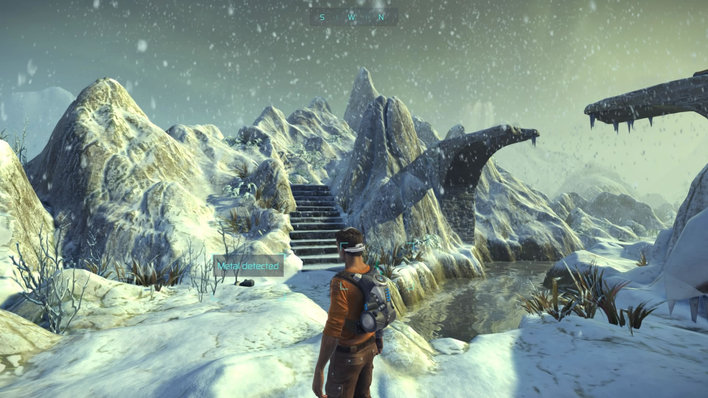
It's a very pretty game, too
Feeling less like an action game at times, and more like a role playing game, Outcast Second Contact is a game that's all about the quests. Rather than dungeon raids or boss fights, however, many of these quests instead simply revolve around finding people, objects, or things, and bringing them together. One character may ask you to find out where his Twon-Ha shipment's got to (a weird cross between a dinosaur and a tauntaun), another might ask for your help in clearing an "accident" that occurred when building a temple, and has left rubble scattered everywhere, or a worker may ask you to fetch a Shamaz (essentially a priest type profession) to help heal him, as he's been beaten up again for falling behind in his Riss production (a type of vegetable of the land). The more quests you complete, the more the Talan at large will begin to trust you, as you gradually work towards persuading them to turn on their masters, and fight back against the power.
What makes Outcast stand out is its combination of quests that simply require you to track someone (or something) down, and a complete lack of anything to tell you where you might be able to find said people. With no quest markers, and no way to set your currently active quest, you instead have to rely on frequent trips to your notepad (which the game automatically updates when you receive hints/tips, as a kind of quest log), and that most ancient form of navigation - asking the locals for directions.
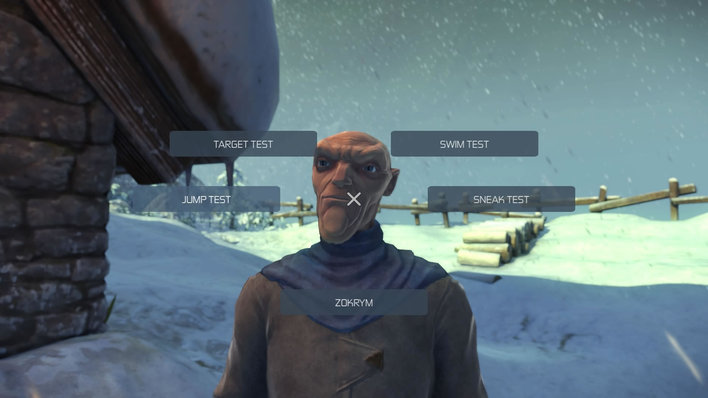
Dialogue options aren't a regular fixture in most action games - but they are in Outcast
No, really. With so many of the quests asking you to track someone down, you'll often find yourself having to collar the nearest Talan, and use the rotary menu that pops up to choose to ask them where the guy you're looking for is. It's an interesting way of doing things - especially as they never really give you a proper location, just a vague "I last saw them north west of me". What works less well is that some Talan give you directions that involve a place, like "north of the Temple Fae", which is much less useful, as while the game does provide a map (although it doesn't bother to tell you it exists), the map is actually completely unlabelled, meaning it's not actually all that useful.
Still, it's not all odd jobs and asking for directions. Combat does play a role in Outcast: Second Contact, but unfortunately, it's one of the ropiest bits of the game. With a odd control scheme that asks you to press the left trigger to aim, and right trigger to shoot, but which will bring up a weapon changing wheel if you press the right trigger without holding the left, it can lead to one too many close shaves, where an enemy rushes at you, and you greet them not with some hot lead, but by showing them your beautiful weapons wheel instead.
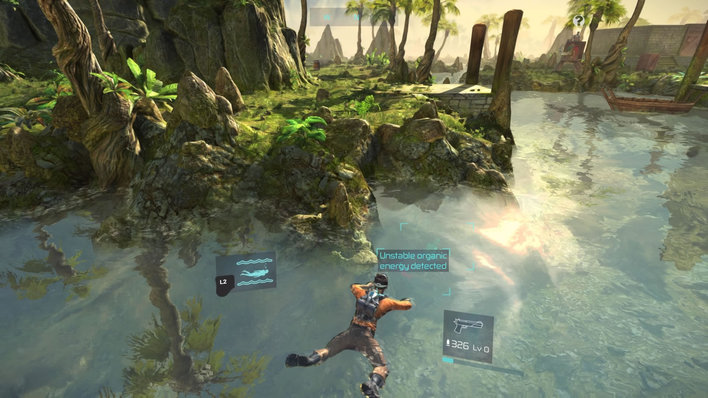
Throughout your adventure, your scanner will detect various items and objects you can collect. You can then use these to get more ammo, or health packs
While there is a generous auto aim that snaps your reticule to enemies, it all feels a little bit hit and miss, with only some enemies getting the lock on treatment, and others managing to evade your every shot. What's perhaps more unusual is that your enemies all use energy based weapons, which, rather than firing a laser like blast, instead fire a really slow, glowing projectile. What that means is, if you're engaging in combat from a distance, you can easily sidestep the enemy's shots - but as your gun seems to fire its bullets every bit as slowly, they can do the same to you too.
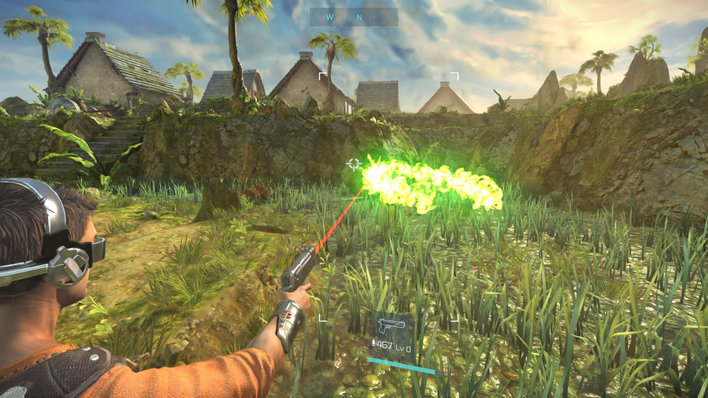
Slide to the left...
However, what lets Outcast: Second Contact down the most is that it's just that little bit too buggy. It's one thing to not offer any quest markers, but it's another thing entirely when your only way of telling what to do next (your notepad) often shows up as being completely and utterly blank. Worse, this isn't a rare bug - it happened to us more than half of the times you open it up, with the only way to fix it being to change to a different tab in the menu, close it, and then open the menu again, before scrolling to the notepad. Weirdly, turning the game (and console) on and off again fixed this, but it's still worth flagging up as a really odd issue.
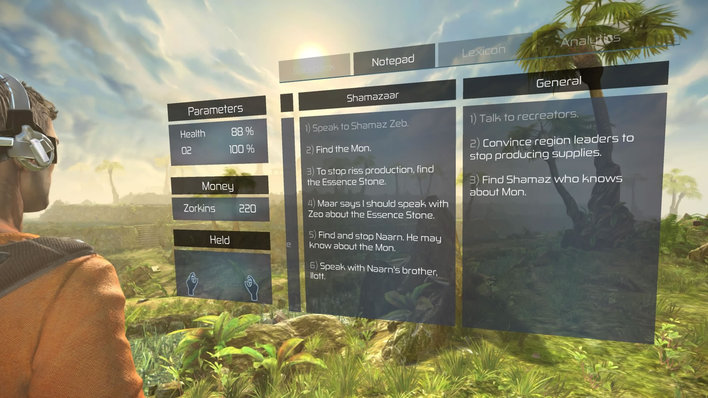
Your notepad is essential to your progress
Similarly, we're not sure whether the lack of labels on the map is by design, or a bug. Sometimes, people's names will appear on the map - but it doesn't seem to have any relation to how close you are to them, or where you are on the map. When you next quest is to find Zeo, but not only are you not sure where he is, but you can't find any Talan to ask either, it's easy to find yourself in a bit of a pickle. While it may seem like a bit of an odd complain, too, we wish everyone would get a move on and actually say what they want to say, rather than spending three or four lines telling you about the history of their people before getting to what you actually want to know.
In all, then, Outcast Second Contact is a really interesting game, and one we got a lot of fun out of thanks to its retro stylings, oddly relaxing pace, and interesting world. With none of the modern comforts of open world games - like the ability to set waypoints on a map - this is a game designed to feel more like an exploration and an adventure, with a soundtrack that'd make the oddly silent Zelda: Breath of the Wild blush. Having to rely on the populace to ask for directions is a really weird idea, yet one that works oddly well, - but the game's bugs, particularly the notepad one, really let it down. Still, having not had the chance to play this almost 20 years ago now, we're glad we've finally been able to sit down, and get lost in the world of Outcast. If you grew up playing games in the 90s, chances are you'll like this too.
Format Reviewed: Playstation 4


